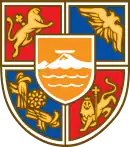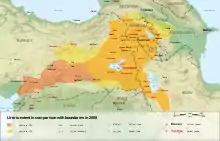Alarodians
Alarodians (Ancient Greek: Ἀλαρόδιοι (Alarodioi)) were tribe living in Northern Persia or Armenia during Classical antiquity.
According to Herodotus, the Alarodians were part of the 18th Satrapy of the Achaemenid Empire and formed a special contingent in the grand army of Xerxes I.[1] Some scholars have tried to link the Alarodians to Urartians, suggesting that Alarodian was a variation of the name Urartian/Araratian. According to this theory, the Urartians of the 18th Satrapy were subsequently absorbed into the Armenian nation.[2] Modern historians, however, have cast doubt on the Alarodian connection to the Urartians.[3]
Nearly nothing is known about Alarodians except that they "were armed like the Colchians and Saspeires," according to Herodotus.[4]
Use of term
The controversial Alarodian language theory, a proposed language family that encompasses the Northeast Caucasian languages and the extinct Hurro-Urartian languages, derives its name from the Alarodians.
An earlier, separate Alarodian language group was proposed by Joseph Karst in 1928. Karst's theory suggested a connection between the Armenian and Basque languages.[5] This theory has also failed to gain mainstream support as Armenian and Basque do not even belong to the same language families.
References
- Lang, pp. 112, 117
- Diakonov, I. The Pre-history of the Armenian People. Delmar, NY: Caravan Books, 1984.
- Zimansky, Paul "Urartian and Urartians." The Oxford Handbook of Ancient Anatolia (2011): 557.
- Herodotus. Book VII: chapters 57‑137.
- Roberto Peter Bongiovanni. "The Interchange of Plain Velar and Aspirate in Kronos/Chronos: A Case for Etymological Equivalence." CUNY. 2014.


